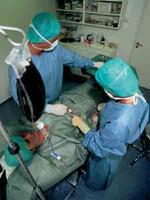The use of PVC compounds in medical device manufacture for more than 50 years has demonstrated its great ability to satisfy the demanding requirements of the medical health care industry.
PVC was originally developed as replacements for natural rubber and glass. Medical devices made from these traditional materials  demanded cleaning and re-sterilisation before re-use. The low cost and high performance of the PVC material made it possible to manufacture single use devices. In the beginning of the sixties this resulted in a revolution within the health care sector.
demanded cleaning and re-sterilisation before re-use. The low cost and high performance of the PVC material made it possible to manufacture single use devices. In the beginning of the sixties this resulted in a revolution within the health care sector.
The PVC based devices improved medical safety by reducing the risk of life-threatening infections caused by the multiple-use of traditional devices.
The two main application areas for medically approved PVC compounds are flexible containers and tubing: containers used for blood and blood components for urine or for ostomy products and tubing used for blood taking and blood giving sets, catheters, heart-lung bypass sets, haemodialysis set etc.
The PVC based devices improved medical safety by reducing the risk of life-threatening infections caused by the multiple-use of traditional devices
In Europe the consumption of PVC for medical devices is approximately 85.000 tons every year. Almost one third of plastic based medical devices are made from PVC. The main reason for this huge consumption is that PVC is safe, chemically stable, inert, extremely versatile and easily fabricated. Medical products made from PVC are usable inside the body, easy to sterilise and simple to assemble into products that do not crack or leak.









